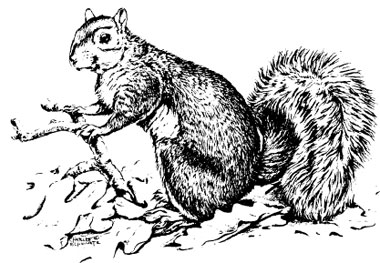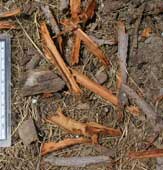
Figure 1. Fox squirrel, Sciurus niger
Bark stripping can occur for a variety of reasons. This page is dedicated to providing clues to help you identify and control the problem.
Contents |
Suspects
Here is a list of species that are known to strip tree bark.
- Beavers (Castor candensis)
- Black bear (Ursus americanus)
- Field mice, such as voles, deer mice, and other small rodents.
- Mountain beavers (Aplondontia rufa)
- Porcupines (Erethizon dorsatum)
- Rabbits, such as the Eastern cottontail (Sylvilagus floridanus)
- Tree squirrels, such as fox squirrels (Sciurus niger Fig. 1) and eastern gray (Sciurus carolinensis).
Identification
Identifying the cause of the bark damage is fairly easy.
Beavers and rabbits can only strip bark as high as they can stand.
Black bear damage typically occurs in the Spring. Stripped bark will lay on the ground. Vertical tooth and claw marks may be noticed. Damage will mostly occur on at the 3-5 foot level of the tree, typically conifers 15-30 years old. Damage may be extensive, up to 70 trees in one day.
Field mice (including voles and deer mice) tend to strip bark during the harsh winter. Damage often takes place along the vertical portion of the trunk that lies beneath the snow.
Mountain beaver damage occurs low on the bole of smaller trees. Tooth marks will be horizontal. Claw marks will be irregular. Twigs often clipped quite high on the tree, leaving 2-inch stubs.
Porcupines rely on tree bark as an essential component of their diet. When they are around, trees, especially tender branches in the upper-most parts of the treee, will be substantially and quickly impacted.
Squirrels typically strip bark in late winter or during periods with low acorn or seed production by trees (Fig 2). Horizontal branches seem to be preferred, but have been known to strip the bark off of trunks too (Fig.3).
Chunks of the outermost bark will also be found on the ground (Fig 4). Squirrels are also noted for the amount of surface area stripped (Fig 5).
Why Do Squirrels Bark Strip?
No one really knows for sure. There are three theories bandied about.
- Gnawing in search of water. This theory looks at bark stripping which occurs during the dry months.
- Gnawing to cope with pain. The idea behind this theory is that pregnant female squirrels late in their term, don’t eat. So the belief is that they gnaw on bark to cope with the pain.
- Gnawing in search of food. This theory holds that squirrels are gnawing in search of the inner bark that would satisfy a particular nutritional need.
Affected Tree Species
Three species of trees have suffered damage. However, we suspect there are others. If you have other findings, please submit them to [1] so we can add them to our list.
- Honey Locust
- Red Maple
- Sycamore
Additional Resources
|
Tree Squirrels | Tree Squirrel Overview | Tree Squirrel Damage Assessment | Tree Squirrel Damage Management | Tree Squirrel Resources | Tree Squirrel Acknowledgments | ICWDM | Wildlife Species Information |




Stephen Vantassel. Project Coordinator,
School of Natural Resources.
University of Nebraska-Lincoln
Lincoln, NE 68583.
Internet Center for Wildlife Damage Management
Dave Pehling. Extension Educator,
WSU Extension Snohomish County
Everett, WA 98208
http://snohomish.wsu.edu/
